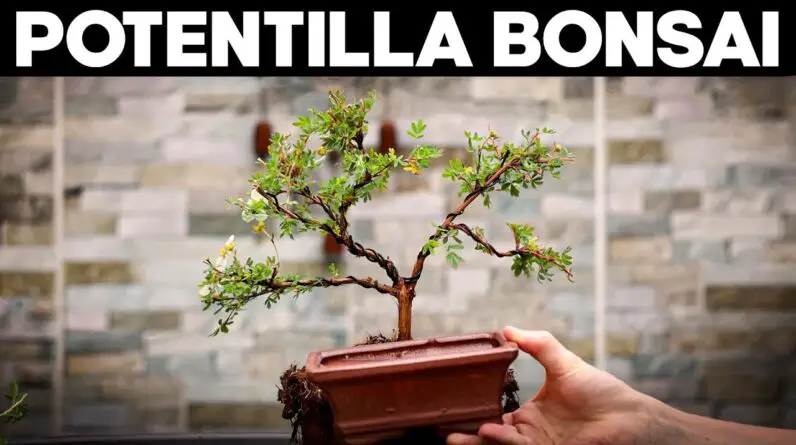
Welcome to our comprehensive guide on creating a Potentilla bonsai! Bonsai is an ancient art form that allows you to grow and shape miniature trees in small containers. Potentilla, with its beautiful foliage and delicate flowers, makes a stunning bonsai tree that is relatively easy to maintain. In this post, we will walk you through the step-by-step process of creating a Potentilla bonsai and provide you with valuable tips and tricks along the way. Whether you are a beginner or an experienced bonsai enthusiast, this guide will help you create a beautiful and healthy Potentilla bonsai that will be the envy of your friends and family. So, let’s get started!
Introduction
Bonsai has become a popular hobby for many, and Potentilla Bonsai is a beautiful and unique addition to any collection. With its small delicate leaves, abundant flowering, flaky bark, and quick development of a compact and graceful form, Potentilla is a perfect bonsai tree for beginners. It is a diverse group of herbaceous perennials, shrubs, and subshrubs that are widely distributed across the Northern Hemisphere. The flowers of Potentilla can be yellow, white, red, pink, or orange, making it a colorful addition to any bonsai collection. In this article, we will provide you with a comprehensive guide on how to create a Potentilla Bonsai, step-by-step.
Selecting the Optimal Front
Before beginning, it is important to select the optimal front of the tree. This is the side of the tree that will be facing the viewer, and it is crucial to find the most aesthetically pleasing angle. Turn the tree around to see which angle is most appealing, ensuring that the front will showcase the tree’s best features.
Addressing Branches
Once you have found the optimal front, identify the branches that need to be addressed. Remove any damaged or unhealthy branches, as well as any branches that are not contributing to the desired structure of the bonsai tree.
Wiring Techniques
Next, it is time to wire the branches. Follow the two-branch principle, which means wiring two branches together as much as possible to ensure that they grow in parallel and create a more natural appearance. Be careful not to wire too tightly, as this can cause damage to the branches. Use aluminum wire to wrap around the branches, starting from the trunk and moving towards the tips of the branches. Ensure that the wire is tight but not too tight and that it is concealed within the foliage.
Dealing with Aphids
One common problem that bonsai owners face is aphids. Aphids are small insects that suck the sap from the leaves of the tree, causing them to become distorted and discolored. To deal with aphids, use a hose to spray the tree, removing as many of the aphids as possible. If the problem persists, use an organic insecticide to get rid of them.
Repotting Your Potentilla Bonsai
The best time to repot a Potentilla Bonsai is late winter or early spring. Make sure to choose a well-draining soil mix, as Potentilla prefers well-drained soil. Remove the bonsai from its pot, and gently remove the old soil from the roots. Trim any roots that are damaged or diseased, and then place the bonsai into its new pot. Add the new soil mix, ensuring that it is spread evenly throughout the pot. Water the bonsai thoroughly, and then wait several hours before adding additional water.
Notion Bonsai Socials for Business Inquiries
For those looking to turn their bonsai hobby into a business, Notion Bonsai Socials is a platform to promote your business inquiries, connect with other bonsai enthusiasts, and expand your knowledge.
Video Tutorial
For a more visual representation of these steps, check out our Bonsai video on how to create a Potentilla Bonsai. The video contains time codes for different procedures and showcases the step-by-step process of selecting the optimal front, addressing branches, wiring techniques following the two-branch principle, and effective methods for dealing with aphids.
Specialized tools of Bonsai
While specialized tools of bonsai could help, they are not necessarily needed. A pair of sharp scissors, some wire cutters, and aluminum wire are the basic tools required to create a Potentilla Bonsai.
Consider All Options and Angles
When creating a Potentilla Bonsai, it is essential to consider all options and angles. Take your time to ensure that the tree reflects the desired structure and form. With patience and care, creating a Potentilla Bonsai can be a rewarding and fulfilling experience.
Conclusion
Creating a Potentilla Bonsai is a beautiful addition to any collection and a perfect option for beginners. Following the step-by-step process of selecting the optimal front, addressing branches, wiring techniques following the two-branch principle, and effective methods for dealing with aphids, you can create your bonsai tree. With patience and care, your Potentilla Bonsai will grow and flourish, becoming a beautiful addition to your garden.
FAQs
- How often should I water my Potentilla Bonsai?
Ans. Watering frequency for your Potentilla Bonsai depends on the soil and environmental conditions. Avoid overwatering and ensure proper drainage. - How do I prune my Potentilla Bonsai?
Ans. Prune your Potentilla Bonsai during the growth period, removing any dead, damaged, or diseased branches. Be sure to maintain its shape and structure. - When should I fertilize my Potentilla Bonsai?
Ans. Fertilize your Potentilla Bonsai during the growing season, approximately once a month, with a balanced fertilizer. - How often should I repot my Potentilla Bonsai?
Ans. Repot your Potentilla Bonsai every two to three years, using well-draining soil mix. - Can I grow a Potentilla Bonsai indoors?
Ans. Potentilla Bonsai can be grown indoors but may need adequate sunlight, humidity, and temperature control. It is essential to research the optimal growing conditions for Potentilla Bonsai before trying to grow it indoors.


